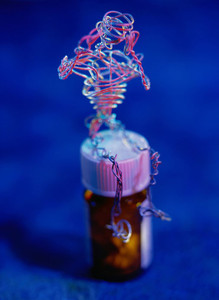Health authorities are looking to increase the utilization of low cost generics to save considerable resources without compromising care. This includes Denmark [1].
Patent-protected angiotensin receptor blockers (ARBs) were potential candidates as they are widely used to treat hypertension (high blood pressure) and heart failure; and a Cochrane Collaboration review concluded all ARBs had a similar effect on blood pressure. There have also been no head to head trials showing any difference in effectiveness between the different ARBs for managing patients with heart failure at appropriate doses. Once losartan became available as a generic drug, all other ARBs alone or as fixed-dose combinations (FDCs) were removed from the reimbursement list in Denmark. Patients could still be prescribed another ARB and have this reimbursed. However, their physician had to justify the rationale and have the explanation accepted before other ARBs could be reimbursed.
A retrospective interrupted time series study was undertaken to compare utilization patterns before and after the changes in ARB reimbursement status for losartan and all other ARBs in Denmark. Utilization was measured in defined daily doses (DDDs) – a way of comparing different drug usage. Changes in total expenditure and expenditure/DDD for losartan were also assessed. The data source was the Danish Prescription Registry, which covers the entire Danish population.
Losartan utilization grew from 31% to 33% of total single ARB utilization before generic losartan became available to 93% by October 2011 following the delisting of all other ARBs. There was a corresponding decrease in the utilization of all other ARBs. The utilization of ARB FDCs remained relatively constant throughout the study period, varying between 34% and 37% of total ARB utilization on a DDD basis. This was principally losartan plus a diuretic once generic losartan FDCs became available in April 2010. All changes were significant (p < 0.001).
Total expenditure on single ARBs in 2011 was 77% below 2009 levels despite a 16% increase in utilization. Savings to the Danish healthcare service were estimated at DKK 290.5 million (Euros 39 million) compared with 2009, assuming a 16% increase in the utilization of each single ARB since 2009 and expenditure/DDD at pre-patent loss prices. This was helped by a 92% reduction in expenditure/DDD for losartan over time.
Measures used in other countries include multiple demand-side initiatives in Sweden and in one English Primary Care Trust (PCT). These involved educational initiatives, formulary changes, therapeutic switching programmes, prescribing targets and financial incentives. In Austria and Belgium, prescribing restrictions were removed for losartan but not for the other ARBs [2].
These initiatives resulted in losartan increasing from 23% to 27% of total ARBs in one English PCT just before multiple initiatives to 65% of total ARBs some 7 months later. In Sweden, utilization of losartan increased from 27% of single ARBs (DDD basis) just before generic losartan to 40% 17 months after. Both changes were statistically significant. There were also significant changes in Austria and Belgium, but to a lesser extent, e.g. in Austria losartan increased from 10% of total ARBs (DDD basis) just before generic losartan was reimbursed and the restrictions lifted, to 17% 34 months after [3].
However, there was no change in losartan utilization in either Ireland, Spain (Catalonia) or Scotland once generic losartan became available with no specific demand-side measures in these countries. This contrasts with the success in Scotland with multiple initiatives, which limited ARB prescribing versus generic angiotensin converting enzyme inhibitors (ACEIs), with the influence of these measures similar to prescribing restrictions in Austria and Croatia.
Consequently, removing patented products within a class once generics become available appreciably limits their utilization and reduces costs. However, this should only be applied to classes where all products are essentially similar at therapeutic doses. Alternatively, instigating multiple measures, including education, prescribing targets, financial incentives and potentially therapeutic switching, can also increase the use of generics.
Without such measures, physicians are reluctant to change their prescribing habits as seen in Ireland, Scotland and Spain following the availability of generic losartan. The findings in Scotland suggest no ‘spill over’ of initiatives from one class to another even if these are closely related.
Conflict of interest
The authors of the research paper [1] declared that there were no conflicts of interest.
Abstracted by Dr Brian Godman, member of International Editorial Advisory Board, GaBI Journal.
Related articles
Generic atypical antipsychotic drugs in Belgium
Godman Critique Price cuts in South Korea
References
1. Hesse U, Godman B, Petzold M, Martin A, Malmström RE. Impact of delisting ARBs, apart from losartan, on ARB utilisation patterns in Denmark: implications for other countries. Appl Health Econ Health Policy. 2013;11(6):677-85.
2. Vogler S, Zimmermann N. How do regional sickness funds encourage more rational use of medicines, including the increase of generic uptake? A case study from Austria. Generics and Biosimilars Initiative Journal (GaBI Journal). 2013;2(2):65-75. doi:10.5639/gabij.2013.0202.027
3. Godman B. National and regional activities by sickness funds in Austria to encourage the rational use of medicines. Generics and Biosimilars Initiative Journal (GaBI Journal). 2013;2(2):58-9. doi:10.5639/gabij.2013.0202.026
Permission granted to reproduce for personal and non-commercial use only. All other reproduction, copy or reprinting of all or part of any ‘Content’ found on this website is strictly prohibited without the prior consent of the publisher. Contact the publisher to obtain permission before redistributing.
Copyright – Unless otherwise stated all contents of this website are © 2014 Pro Pharma Communications International. All Rights Reserved.








 0
0











Post your comment